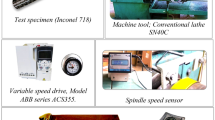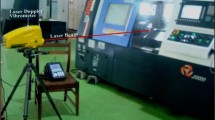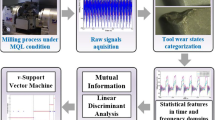Abstract
Titanium alloys are the difficult to cut metals due to their low thermal conductivity and chemical affinity with tool material. Since the tool vibration is a replica of tool wear and surface roughness, the present study has proposed a methodology for estimating tool wear and surface roughness based on tool vibration for milling of Ti-6Al-4V alloy using cemented carbide mill cutter. Experiments are conducted at optimum levels of cutting speed, feed per tooth, and depth of cut, and experimental results for the tool vibration, tool wear, and surface roughness are collected until the flank wear reached 0.3 mm (ISO3685:1993). In the next stage, an optimization model of grey prediction GM(1,N) system and support vector machine (SVM) are used and estimated tool wear and surface roughness related to tool vibration. The predicted values of tool wear and surface roughness are compared with the experimental results. The optimization model of GM(1,N) predicted the tool wear and surface roughness with an average error of 3.03% and as 0.7% respectively while the SVM predicted with an average error of 7.67% and 4.45%, respectively.







Similar content being viewed by others
References
Prasad BS, Sarcar MMM, Satish Ben B (2010) Development of a system for monitoring tool condition using acousto-optic emission signal in face turning—an experimental approach. Int J Adv Manuf Technol 51:57–67
Prasad BS, Babu MP (2017) Correlation between vibration amplitude and tool wear in turning: numerical and experimental analysis. Eng Sci Techn, an Int J 20(1):197–211
VenkataRao K, Murthy PBGSN, Vidhu KP (2017) Assignment of weightage to machining characteristics to improve overall performance of machining using GTMA and utility concept. CIRP J Manuf Sci Tech 18:152–158
Hui Y, Mei X, Jiang G, Tao T, Pei C, Ma Z (2019) Milling tool wear state recognition by vibration signal using a stacked generalization ensemble model. Shock Vib 2019:7386523, 16 pages–7386516. https://doi.org/10.1155/2019/7386523
Suyama DI, Diniz AE (2020) Influence of tool vibrations on tool wear mechanisms in internal turning of hardened steel. J Braz Soc Mech Sci Eng 42:370
Huang X, Zou F, Ming W, Xu J, Chen Y, Chen M (2020) Wear mechanisms and effects of monolithic Sialon ceramic tools in side milling of superalloy FGH96. Ceram Int 46(17):26813–26822
Xu L, Huang C, Li C, Wang J, Liu H, Wang X (2020) Estimation of tool wear and optimization of cutting parameters based on novel ANFIS-PSO method toward intelligent machining. J Intell Manuf 32:77–90. https://doi.org/10.1007/s10845-020-01559-0
Wang GF, Xie QL, Zhang YC (2017) Tool condition monitoring system based on support vector machine and differential evolution optimization. Proc I Mech Eng Part B: J Eng Manuf 231(5):805–813
Venkatarao K, Murthy PBGSN (2018) Modeling and optimization of tool vibration and surface roughness in boring of steel using RSM, ANN and SVM. J Intell Manuf 29:1533–1543
Gupta P, Singh B (2020) Local mean decomposition and artificial neural network approach to mitigate tool chatter and improve material removal rate in turning operation. Appl Soft Comput 96:106714
Xia M, Wong WK (2014) A seasonal discrete grey forecasting model for fashion retailing. Knowl-Based Syst 57:119–126
Deng JL (1982) Control problems of grey systems. Syst Control Lett 1:288–294
Liu W, Jia Z, Zou S, Zhang L (2014) A real-time predictive control method of discharge state for micro-EDM based on calamities grey prediction theory. Int J Adv Manuf Technol 72:135–144
Lin Y, He S, Lai D, Wei J, Ji Q, Huang J, Pan M (2020) Wear mechanism and tool life prediction of high-strength vermicular graphite cast iron tools for high-efficiency cutting. Wear 454-455:203319
Ding S, Hipel KW, Dang YG (2018) Forecasting China’s electricity consumption using a new grey prediction model. Ener 149:314–328
Deng JL (1988) Essential topics on grey systems: theory and applications. China Ocean Press, Beijing
Chiang KT, Chang FP (2007) Applying grey forecasting method for fitting and predicting the performance characteristics of an electro-conductive ceramic (Al2O3+30%TiC) during electrical discharge machining. Int J Adv Manuf Technol 33:480–488
Zeng B, Luo C, Liu S, Bai Y, Li C (2016) Development of an optimization method for the GM(1,N) model. Eng Appl Artif Intell 55:353–362
Huang PTB, Zhang HJ, Lin YC (2019) Development of a grey online modeling surface roughness monitoring system in end milling operations. J Intell Manuf 30:1923–1936
Liu SF, Lin Y (2010) Grey system theory and applications. Springer-Verlag, Berlin Heidelberg 2010:107–147
Wei BL, Xie NM, Yang YJ (2019) Data-based structure selection for unified discrete grey prediction model. Expert Syst Appl 136:264–275
Zhang L, Jia Z, Wang F, Liu W (2010) A hybrid model using supporting vector machine and multi-objective genetic algorithm for processing parameters optimization in micro-EDM. Int J Adv Manuf Technol 51:575–586
Vapnik V (1998) Statistical learning theory. Wiley Interscience, New York
Agrawal C, Wadhwa J, Pitroda A, Iulian Pruncu C, Sarikaya M, Khanna N (2021) Comprehensive analysis of tool wear, tool life, surface roughness, costing and carbon emissions in turning Ti–6Al–4V titanium alloy: cryogenic versus wet machining. Tribol Int 153:106597
Mamalis AG, Kundrák J, Markopoulos A, Manolakos DE (2008) On the finite element modelling of high speed hard turning. Int J Adv Manuf Technol 38:441–446
Hsieh WH, Lu MC (2012) Chiou SJ (2012) Application of backpropagation neural network for spindle vibration-based tool wear monitoring in micro-milling. Int J Adv Manuf Technol 61:53–61
Camach PYS, Ocampo JBR, Soria JM, Orantes FL (2015) Tool failure detection method for high-speed milling using vibration signal and reconfigurable bandpass digital filtering. Int J Adv Manuf Technol 81:1187–1194
Availability of data and materials
The authors confirm that the data supporting the findings of this study are available within the article.
Author information
Authors and Affiliations
Contributions
Dr. K Venkata Rao designed the experimental plan and supervised the experimentation. Dr. Rao is also involved in optimization of process parameters and writing the manuscript. In addition, tool wear in the study were studied. Dr. Y Prasanna Kumar and Dr. L Suvarna Raju proposed and executed the methodology for tool condition monitoring using the grey prediction model. Dr. Vijay Kumar Singh and Mr. Jinka Ranganayakulu are involved in experimentation and collected experimental results and are also involved in writing the manuscript.
Corresponding author
Ethics declarations
Ethics approval and consent to participate
Not applicable.
Consent for publication
Not applicable.
Competing interests
The authors declare no competing interests.
Additional information
Publisher’s note
Springer Nature remains neutral with regard to jurisdictional claims in published maps and institutional affiliations.
Rights and permissions
About this article
Cite this article
Rao, K.V., Kumar, Y.P., Singh, V.K. et al. Vibration-based tool condition monitoring in milling of Ti-6Al-4V using an optimization model of GM(1,N) and SVM. Int J Adv Manuf Technol 115, 1931–1941 (2021). https://doi.org/10.1007/s00170-021-07280-3
Received:
Accepted:
Published:
Issue Date:
DOI: https://doi.org/10.1007/s00170-021-07280-3




